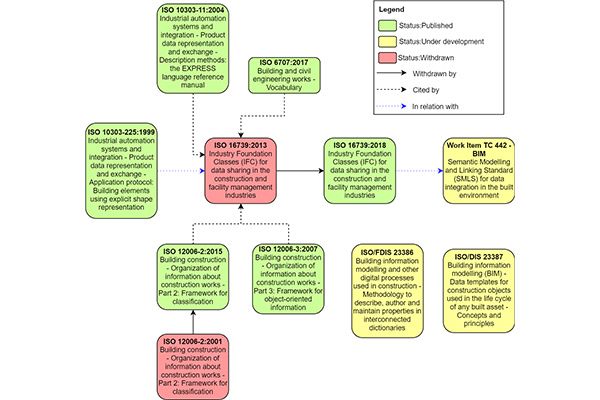These issues reveal the motivation for the application of Web of Data technologies for building energy renovation, that would allow on one side a better representation of buildings and a better exchange of information, besides opening to a number of features including fast querying, deep reasoning, etc.. Relying on the requirement specifications published on the Work Package 2 deliverables available here, BIM4EEB aims at a series of goals: analysing existing data models vocabularies and ontologies helpful in the representation of renovation processes; developing appropriate ontologies for an homogeneous workflow and finally integrating them in the same framework.
The first step is the analysis of the available data schemas for building information exchange. IFC, also recognized and regulated from ISO as ISO 16739, represents the most used information exchange standard of the construction industry. Started as an initiative of BuildingSMART (former International Alliance for Interoperability - IAI), a consortium of CAD software houses, it became an ISO standard in 2005 with the ISO/PAS 16739:2005 initiative, which was succeeded by versions of 2013 and 2018 respectively representing the schema versions IFC4 and IFC4 ADD2 TC1. The exchange protocol refers to five different standards with different roles: the Industry Foundation Classes (IFC) data schema, with objects and relations; International Framework for Dictionaries (IFD and ISO 12006-3), which provides a taxonomy model for the schema; BIM Collaboration Format (BCF), an open standard commonly used for communication about issue management; Information Delivery Manual (IDM), setting the rules for information exchange between project participants; and finally Model View Definitions (MVD), defining output sets for different model views. More recently, some research efforts have translated the IFC schema from the native language, EXPRESS, to OWL, bringing to the IFC-based ontology ifcOWL2. As it represents the openBIM standard data schema in OWL language, it has been chosen as the core of the ontology framework for BIM4EEB, but other ontologies have been analysed too.
In order to achieve an effective progress in interoperability from the point of view of renovation, a list of features and disciplines to be integrated in the standard methods and schemas has been made, and they are:
- Improved workflow management;
- Occupant behaviour and comfort;
- Equipment and material parameters;
- Indoor Air Quality (IAQ);
- Acoustics;
- Smart urban energy system connections;
- Building performance.
The main reason for the integration of other ontologies is the complexity of ifcOWL, inherited from the original IFC schema. Usually, ontologies have simple and modular structures, in order to ease the complexity of the domain to be represented. An example of analysed ontology is Building Topology Ontology (BOT), an effort of the Linked Building Data Community Group (LBDCG), hosted by the World Wide Web Community (W3C) since 2012 and working on interoperability with Semantic Web technologies. It represents the core topological concepts of a building in its context, aiming to be a baseline for the extension in various domains, from Building Management Systems (BMS) to Smart City technologies. It responds to basic principles of relationship between definitions of zones, spaces and volumes. Several alignment modules have been designed, as dictionaries to translate the ontologies into different schemas, including ifcOWL.
Ontologies inside a framework are divided by function, and some of them are useful for fundamental categories, time periods, agents and social networks, units of measurement, etc. This is why it was necessary to consider inside the framework ontologies like Basic Formal Ontology (BFO), OWL-Time as time ontology, Friend of a Friend (FOAF) and Quantities, Units, Dimensions and Types (QUDT) as respectively ontologies for people and units of measurement representation.
All the cited aspects of integration in the framework are harmonized with the requirements of BIM4EEB tools. The project indeed foresees tools that vary from the fast mapping to the human-machine interaction tools. This work, as pictured in the figure, aims at providing a project vocabulary with referenced data types and structures, tailored on BIM4EEB data requirements collected from expert partners of the project.
1 Source: The European Green Deal, accessed on 2/04/2020 at: https://ec.europa.eu/info/sites/info/files/european-green-deal-communication_en.pdf
2 Learn more at: https://standards.buildingsmart.org/IFC/DEV/IFC4/ADD2_TC1/OWL/index.html
 BIM4EEB
BIM4EEB